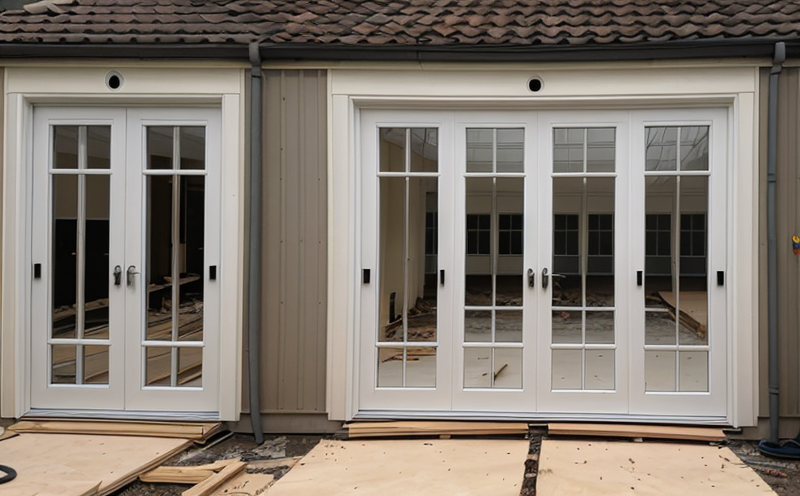Fire Resistance Testing of Glazed Partitions
The fire resistance testing of glazed partitions is a critical component in ensuring that buildings and structures meet the necessary safety standards. This service ensures the integrity, durability, and performance of glazed partitions during simulated fire conditions. These partitions are often used in high-risk areas such as hospitals, schools, and commercial buildings where the safety of occupants is paramount.
The testing process involves subjecting the partition to controlled fire exposure under specific time-temperature curves that mimic real-world fire scenarios. The primary objective is to assess how well the partition can resist heat transfer and maintain structural integrity for a specified period. This service is essential in verifying compliance with international standards such as ISO 14693, EN 13679, and ASTM E1920.
For accurate testing, the specimen preparation must be precise. The partition should be cut to the exact dimensions required by the test protocol, ensuring that all glazed components are included in the sample. The partition is then mounted onto a support frame designed to simulate real-world conditions accurately. Once prepared, the specimen undergoes rigorous fire exposure.
The testing apparatus used for this service includes a furnace capable of generating high temperatures and controlled atmospheres. The furnace can be programmed to follow specific time-temperature curves that replicate various fire scenarios. The partition is exposed to these conditions for predetermined durations, during which temperature sensors monitor the heat transfer through the partition.
After the test period, the integrity of the partition is evaluated based on several criteria. These include the extent of structural damage, the ability to retain glazed components, and the degree of smoke and flame penetration. Compliance with international standards such as ISO 14693 ensures that these tests are conducted in a consistent and reliable manner.
Fire resistance testing plays a crucial role in ensuring public safety and compliance with building codes. It helps identify potential weaknesses in partition design and construction, allowing for necessary modifications to enhance fire protection. This service is particularly important for architects, engineers, and developers looking to incorporate glazed partitions into their projects confidently.
| Applied Standards |
|---|
| - ISO 14693:2015 – Fire resistance tests of doors, windows and building elements |
| - EN 13679:2018 – Fire resistance testing equipment for doors, windows and partitions |
| - ASTM E1920-14: Standard test method for fire resistance tests of door assemblies |
Applied Standards
The testing of glazed partitions adheres to several international standards, ensuring that the process is both rigorous and consistent. These include:
- ISO 14693:2015: This standard provides guidelines for fire resistance tests on doors, windows, and building elements. It outlines the procedures for conducting these tests to ensure accurate and reliable results.
- EN 13679:2018: This European standard specifies requirements for fire resistance testing equipment used in door, window, and partition testing. Ensuring that the equipment meets these standards guarantees consistent and reproducible test outcomes.
- ASTM E1920-14: The American Society for Testing and Materials provides this standard method for conducting fire resistance tests on door assemblies. This ensures that all testing processes are aligned with recognized best practices in the industry.
The adherence to these standards not only guarantees accurate results but also supports compliance with local building codes and regulations. By using internationally recognized protocols, we ensure that our services meet the highest standards of quality and reliability.
Quality and Reliability Assurance
- Consistent Testing Procedures: Our laboratory follows standardized procedures for specimen preparation, furnace operation, and data recording. This ensures that each test is conducted in a uniform manner.
- Advanced Instrumentation: Utilizing state-of-the-art testing equipment allows us to provide precise and accurate results. The use of advanced temperature sensors and monitoring systems enhances the reliability of our findings.
We are committed to maintaining the highest standards of quality in all aspects of our services. This includes rigorous calibration and maintenance of our testing equipment, as well as ongoing training for our staff to ensure that they are up-to-date with the latest industry practices and methodologies.
Customer Impact and Satisfaction
- Enhanced Safety: By ensuring that glazed partitions meet fire resistance standards, we contribute to safer environments. This is particularly beneficial for high-risk areas like hospitals, schools, and commercial buildings.
- Compliance Assurance: Our services help our clients achieve compliance with local building codes and international standards. This reduces the risk of legal issues and ensures that projects are up-to-date with current regulations.
We strive to exceed our customers' expectations by providing accurate, reliable test results within agreed timelines. Regular feedback from our customers is crucial in refining our processes and ensuring continuous improvement in our services.





